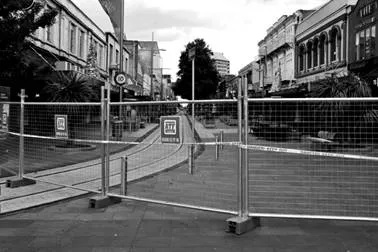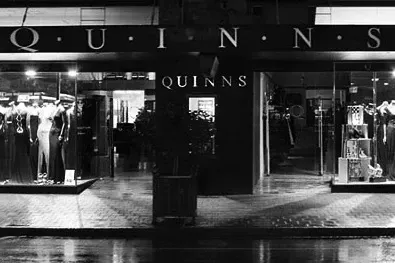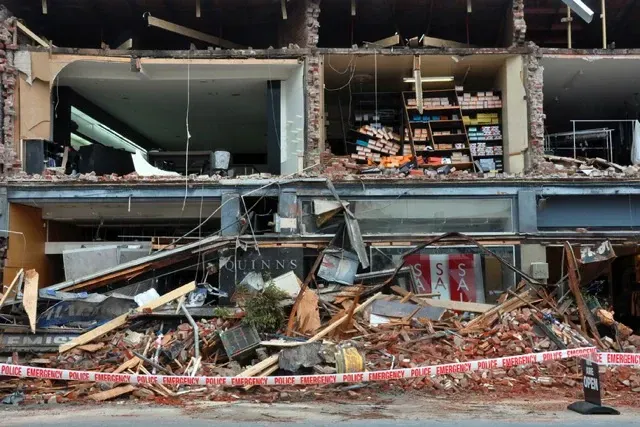Rebuilding fashion retail

Three months on from the Christchurch earthquake, Fashion Industry New Zealand (FINZ) revisits clothing retailers in the Red Zone as they attempt to get their businesses back on track. Mapihi Opai reports on the key issues and future prospects for fashion as the city works towards reopening a section of the CBD.
Taking Stock of High Street
Among those hardest hit were clothing merchants on High Street, an established shopping precinct in the Red Zone that boasted the city’s highest concentration of mainstreet fashion retail. Many of these businesses, fashion chains, independent retailers and designer flagship stores included, have yet to gain access to their premises or recover any of the contents.
Storm general manager, Deborah Caldwell, says: “We’re still waiting to see whether there will be a window of opportunity to rescue anything from the High Street store before the bulldozers move in. But, I’m not prepared to let staff enter the building until we have a full engineer’s report. It’s too dangerous.”
Plume owner, Margi Robertson, says: “The windows are gone and one side of the building has collapsed, so we would need to erect a secure internal structure to enter the store. It’s not just the stock that we’ve lost, but the fittings and fixtures as well, which include a lot of unique pieces that had been commissioned and collected over the years.”
Ruby and numerous other High Street retailers are unsure when or whether they will be able to enter their buildings. And a salvage mission was never on the cards for stores like World and Workshop, which were all but destroyed in the earthquake. The few that have managed to retrieve stock so far include Andrea Moore, Trelise Cooper and Victoria Black.
Andrea Moore director, Brian Molloy, says: “We got most of the stock out six weeks after the earthquake. But it needed to be cleaned and the bulk will have to go into our upcoming sale shop. The site has extensive damage and is likely to be demolished. A lot of the buildings along High Street are going to have to come down.”
Only a small number of people have been allowed inside the Red Zone, but the Canterbury Earthquake Recovery Authority (CERA) has just posted detailed video footage on the eqstreetcam website, which allows you to navigate the city’s inner-city streets. The high-resolution images, captured by Terralink back in April, provide a timely reminder of just how much damage was done to buildings and businesses alike in the CBD.
Immediately following the earthquake, High Street fashion retailers scrambled to try and cancel stock for Autumn/Winter 2011, much of it already in production or otherwise en route to stores broken-down and inaccessible in the Red Zone. By all accounts, local suppliers have been remarkably supportive, offering extended payment terms or writing-off existing purchase orders and carrying the weight of any excess stock themselves.
“Our New Zealand suppliers were happy to cancel existing orders, but there was no way to change or cancel orders from the northern hemisphere. We probably have more stock than we can sell in the Dunedin store, but we’re lucky that very little of winter was delivered before February 22,” says Robertson.
The Fashion Fallout
For clothing merchants in the Red Zone, the fallout from the February earthquake has varied. Sizable multi-site fashion retailers have fared better than those with just one or two stores. And it’s been business as usual for some, but not all, major retail chains.
Adventure clothing retailer Kathmandu hasn’t skipped a beat. The Christchurch-based company, which operates more than 90 stores in New Zealand, Australia and the U.K, has just announced plans to build a new multi-million dollar distribution centre in Woolston. And sales for the year to date, from 1 August 2010, are up 23.1 percent.
Kathmandu chief financial controller, Mark Todd, says: “Our head office was fully operational the week following the earthquake. The Cashel Mall site is closed indefinitely, but Riccarton and Tower Junction are trading well, and we’ve just opened a new store in Papanui.”
Hallenstein Glasson, on the other hand, didn’t escape unscathed. The Kiwi fashion giant, which operates more than 110 retail stores in New Zealand and Australia, announced that group sales for the 17 weeks to May 29 dropped 2.4 percent from the previous year, attributing the downturn to an exceptionally mild winter and the loss of seven stores in Christchurch.
Other merchants with multiple sites in the Canterbury region have benefited from being able to redirect customers, staff and any excess stock from the Red Zone to neighbouring locations. Storm, a subsidiary of Hallenstein Glasson, has eight retail outlets in New Zealand, including two in Christchurch; the now defunct High Street store and another in Merivale Mall.
Storm general manager, Deborah Caldwell, says: “Our High Street customers have been travelling to Merivale, but the entire store is just frozen on the books. We will recoup the immediate loss, but we’re still down one site, which will have an impact on trade and cashflow going forward.”
Independent fashion retailer Kimberleys, which carries local and international labels as well as its own in-house brands, has 17 retail sites in New Zealand, five of them in Christchurch, including its flagship store in Merivale Mall and a boutique on Victoria Street that was damaged in the earthquake. The inner-city building also houses the Christchurch-based company’s head office and outlet store.
Kimberleys general manager, Stacey Mortimer, says: “Head office is up-and-running again and we’re looking for a positive result. But we did have to shift our operations to the Fendalton store temporarily, which is where we took receipt of deliveries for Autumn/Winter 2011. Our retail staff ensured that all of the out-of-town branches received stock as quickly as possible, while most of the office staff worked remotely.
“The Merivale store was trading within the week, followed by Fendalton as soon as we could move our operations back to head office. The newly renovated store in Riccarton was launched on May 25 and the outlet store reopened earlier in the month. Unfortunately, the Victoria Street store will remain closed until further notice.”
Standalone boutiques like Victoria Black have suffered the most disruption. The independent multi-brand stockist, which carries international designer labels such as Dries Van Noten and Ann Demeulemeester, was forced to abandon its prominent position on High Street and the business is “on hold” until another suitable retail site can be found.
Similarly, Plume also had just one store in Christchurch. But the Dunedin-based company, which produces the fashion label NOM*D, is bolstered by solid wholesale trade and another boutique in its home town.
Plume owner, Margi Robertson, says: “It’s incredibly difficult, but we’re an established company and this is not going to tip us over. We had adequate insurance, so our Christchurch retail staff are still being paid and we’re hoping to reopen soon. We’ve spent 29 years building a relationship with Cantabrians and it would be nice to honour that loyalty.”
Location, Location, Relocation?
A number of displaced High Street residents are actively scouting new properties, but there hasn’t been a fashion stampede into the suburbs of Christchurch just yet. Independent retailers are still working through insurance claims. And, many of them are waiting for a clear indication of how the city and surrounding areas will look before they make any long-term commitments.
World director, Francis Hooper, says: “Things are moving very slowly. WORLD is committed to reopening in Christchurch, but the aftershocks are still coming and the city has only just begun to regroup and rebuild. The main challenge is finding the right environment, the right neighbourhood and the right fit for WORLD. Time is on our side, so maybe 2012?”
RCM director, Chris Cherry, says: “The Workshop store was bulldozed a couple of months ago and we’re still working through the long-term issues of business and relocation. Our immediate concern is identifying the right area to relocate to. We’re still unsure at this stage, but have been investigating a number of interesting possibilities. My instinct is that the CBD will recover, but it’s going to take time.”
Demolition is the only work taking place so far in the Red Zone. The Canterbury Earthquake Recovery Authority (CERA) reported that around 900 inner-city buildings and a further 300 suburban commercial properties will have to be demolished. Thousands more lie in various states of disrepair.
With retail space in high demand, it’s slim pickings across the board. And for boutique fashion retailers, ideally clustered with likeminded vendors on the mainstreet, the options as they stand are virtually nil.
Outside the CBD, Christchurch is dominated by large-scale retail and shopping centres; 24 in total, including Eastgate, Northlands, The Palms and Westfield Riccarton, the latter of which consistently ranks among the country’s top-three malls in terms of annual turnover.
Match Realty director, Jeff Vesey, says: “Shopping malls are a major force in Christchurch. One of the biggest challenges for independent fashion retailers is finding something outside the CBD that will work for them. It has to be a destination where their existing customers are willing to go and they need to weigh-up whether they can do the turnover. But you can’t find retail space in any of the established shopping precincts right now.”
Yet to find a commercial property of any description that complements its clientele, Victoria Black is now considering whether or not to move into an upscale residential area and convert a private villa.
Victoria Black director, Malcolm Fleet, says: “Relocation and retail fit-outs are expensive. It would cost around NZ$250,000 to recreate the High Street store, so it would be silly for us to go somewhere we can’t stay. The space and location have to be right. We can’t afford to make a mistake or it could mean the end of Victoria Black.”
Starfish also struggled to find suitable retail space when its Cashel Mall store was damaged and made inaccessible by the cordon surrounding the Red Zone. With a third of its domestic retail trade on hold, relocation was critical for the Wellington-based company, which was not insured for business interruption. And it has since transferred its Christchurch store manager and stock to Auckland, having secured a three-month lease on Ponsonby Road.
For Lynn Woods, who operates her own eponymous boutique as well as the Trelise Cooper store on High Street, now scheduled for demolition, an interim solution was to join forces with another purveyor of premium goods. And the well-connected fashion retailer has been trading from the New White Interiors showroom in Riccarton, until the time comes when she can reoccupy her Victoria Street store.
Merivale and the area surrounding Westfield Riccarton have been cited as the best long-term prospects for fashion retail outside the CBD, followed by Hornby or Barrington. But there’s little opportunity for expansion in most of these areas, due to the encroachment of high-density residential dwellings. And when it comes to fashion, one site doesn’t necessarily fit all.
Plume owner, Margi Robertson, says: “We tried to picture ourselves in Riccarton, but felt that we would be compromising our philosophy and what we do. There are a couple of other options though, still to be developed as opposed to existing sites, which might be viable for a group.”
Keen to stay with the pack, companionable fashion retailers with a shared customer base are keeping the channels of communication open, going back-and-forth over the potential scenarios for relocation, most of them still some way off on the horizon.
Taking Care of Business
The February earthquake, New Zealand’s first major natural disaster since Napier was levelled in 1931, exposed grey areas in the fine print of insurance policies and property leases. The fashion retailers that FINZ spoke to, all of them seasoned traders, had fairly comprehensive insurance coverage. But there were countless smaller clothing merchants that could not be reached and may be treading water.
Match Realty director, Jeff Vesey, says: “Insurance for business interruption has been a blessing for some and a major blow for others. Depending on the individual policy, not all businesses will receive full compensation for loss of income, because of depopulation in the CBD and issues regarding access to undamaged buildings and stock in the Red Zone. Some fashion retailers are now asking themselves why they paid it.
“There are also clashes over property leases on some of the buildings in the Red Zone that were untouched. While the tenants have not been able to access their premises due to the cordon, landlords are refusing to negate their leases on the grounds that the buildings are still fully operational and up to code. There are letters going between lawyers and we can expect to see some cases going to court.”
On the flipside, consumers have been paid-out relatively quickly for their home contents insurance, which comes as good news for fashion retailers. Replacement shopping has boosted retail sales, reflected by an increase in the volume of electronic card transactions in April, up 5.3 percent from the previous year as Christchurch businesses returned to trade.
Paymark sales and marketing manager, Paul Whiston, says: “The trend upwards during April comes as a result of the pick-up in Canterbury spending and growth in clothing and footwear sales as we move into winter.”
With the CBD closed and shopping malls in the eastern suburbs slow to recover after the earthquake, retail trade was above average in areas like Merivale, Riccarton and Barrington, which respectively lie north, west and south of the central city.
Christchurch retailer Quinns, which carries more than 250 fashion brands across its 11,000sq.ft women’s department store in Merivale Mall, reopened within two weeks. The site is currently operating at 60 percent capacity, with damaged areas blocked off to the public, but has been trading well above average nevertheless.
Quinns director, Patrick Quinn, says: “All of the competition in the city was knocked-out, which has reduced the number of fashion retailers considerably. It’s certainly not something we would have ever wished for, but it has been a windfall and business is booming.”
Storm general manager, Deborah Caldwell, says: “People are still spending money on fashion. Our Christchurch customers have been buying everything that you would assume they would want at this time of the year. Some people have hardly been affected. Then you have the other extreme, where people have lost everything.”
Kimberleys general manager, Stacey Mortimer, says: “All of the Christchurch sites are trading well, particularly Merivale, and we’ve had good foot traffic through the outlet store. There’s been no noticeable change in what people are buying, but some of them are looking for a bargain rather than an entire wardrobe for winter. I think people are shopping to help make themselves feel better.”
Landmark department store Ballantynes is yet to reopen on Cashel Mall. But the multi-site retailer has been ferrying Christchurch customers to the Timaru store for ‘fashion, beauty and fun’ with its Girls’ Day Out bus trips running every Thursday and Sunday.
Around 400 shoppers boarded the bus in the first week of May and hundreds more have already booked seats for upcoming buying sprees. At NZ$20 a pop, the fare includes high tea. And the initiative has seen sales at the Timaru store quadruple since the same time last year.
Ballantynes managing director, Mary Devine, says: “Girls’ Day Out has been a big hit. It’s all about trying to be innovative and creating opportunities in challenging conditions. We bumped-up our product ranges and expanded core clothing lines like Paula Ryan, which is going gangbusters. Fashion is really driving it.”
Reopening the CBD
The findings of a recent survey conducted by the Canterbury Business Leaders Group show that a fast rebuild is imperative, followed closely by the reopening of the CBD and repair of its infrastructure. Respondents also indicated that they expect to see clear plans and visible action within six months in priority areas, including business recovery.
Christchurch City Business Association central city manager, Paul Lonsdale, says: “This is a great opportunity to design a world-class shopping precinct and we need to raise business confidence. As the city is rebuilt, leases will have to be flexible, no more than NZ$250 per square metre, and the retail footprint needs to be tightened-up to create some critical mass.”
Urban design experts from Copenhagen-based Gehl Architects arrived last month to work with the Christchurch City Council on developing a Central City Plan. And the Canterbury Earthquake Recovery Authority (CERA) aims to have all demolition work completed by June, to make way for the phased reopening of the CBD, which will initially centre on Ballantynes and City Mall.
RE:START 29.10.11, which aims to re-establish business activity in the CBD, will see retail and hospitality in existing buildings, combined with high-quality relocatable structures, open for business on October 29 in preparation for New Zealand Cup & Show Week and Christmas trading.
“Christchurch will be one of the first pop-up cities in recent history and the eyes of the world will be on us. It’s a great opportunity for New Zealand brands and we see fashion as critical to making it a success,” says Lonsdale.
“Boxpark, a pop-up mall in London, showcases designer brands in converted industrial shipping containers to an extremely high standard. And we could look at developing a similar concept here, creating a provisional precinct just for fashion.”
Ballantynes managing director, Mary Devine, says: “The major challenge is gaining the clarity to make firm decisions. Getting clarity from insurance companies, understanding the new building codes and finding out when building consents will be available. Moving forward with the information that we have on hand. And controlling what can be controlled.
“We’re lucky that City Mall property owners are working together as a cohesive group to develop the look and feel of the area. We want to cluster key segments and support independent retailers through this difficult time, because they’re important to Christchurch and the character of the city.”

